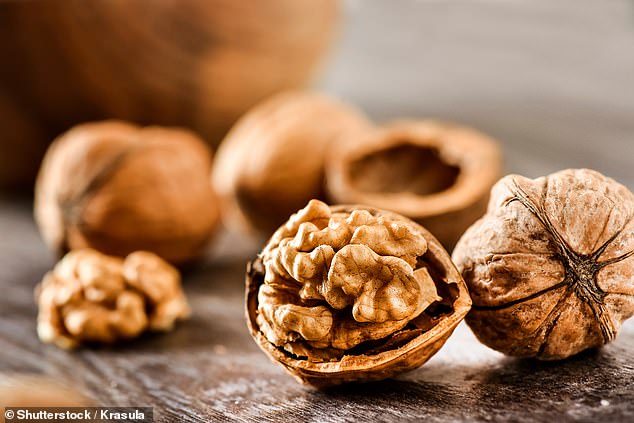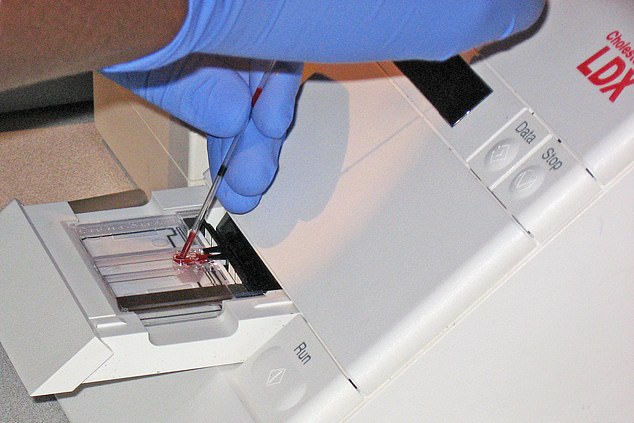Adding half-a-cup of walnuts to your daily diet can lower your cholesterol levels by around 8.5 per cent and reduce the risk of heart disease, a study has found.
Researchers from the Hospital Clínic de Barcelona recruited 628 adults and put half of them on a diet which included daily walnut consumption.
After two years, the team found the walnut eaters also had modest reductions in their so-called low-density lipoprotein (LDL) cholesterol levels.
High levels of LDL — sometimes dubbed the ‘bad cholesterol’ — is linked to an increased risk of heart disease and stroke.
Study participants who ate walnuts daily saw a reduction in both the total number of LDL particles in their blood and, in particular, the number of small LDL particles.
According to the American Heart Association, walnuts are high in omega 3 fatty acids — the heart-healthy fat famously found in oily fish.

Adding half-a-cup of walnuts (pictured) to your daily diet can lower your cholesterol levels by around 8.5 per cent and reduce the risk of heart disease, a study has found
WHAT IS HIGH CHOLESTEROL?
Cholesterol is a fatty substance that is vital for the normal functioning of the body.
But too much can cause it to build up in the arteries, restricting blood flow to the heart, brain and rest of the body.
This raises the risk of angina, heart attacks, stroke and blood clots.
Cholesterol is made in the liver and is carried in the blood by proteins.
The first – high-density lipoprotein (HDL) – carries cholesterol from cells to the liver where it is broken down or passed as waste. This is ‘good cholesterol’.
‘Bad cholesterol’ – low-density lipoprotein (LDL) – carries cholesterol to cells, with excessive amounts then building in the artery walls.
High cholesterol can be genetic but it is also linked to a diet rich in saturated fat, as well as smoking, diabetes, high blood pressure and a family history of stroke or heart disease.
Blood cholesterol is measured in units called millimoles per litre of blood, often shortened to mmol/L.
A healthy adult’s overall level should be 5mmol/L or less, while their LDL level should be no more than 3mmol/L. An ideal level of HDL is above 1mmol/L.
Cholesterol can be lowered by eating a healthy, low-fat diet; not smoking; and exercising regularly.
If these do not help, cholesterol-lowering medication like statins may be prescribed.
Source: NHS
Advertisement
‘Prior studies have shown that nuts in general, and walnuts in particular, are associated with lower rates of heart disease and stroke,’ said paper author and nutrition expert Emilio Ros of the Hospital Clínic de Barcelona, in Spain.
‘One of the reasons is that they lower LDL-cholesterol levels, and now we have another reason: they improve the quality of LDL particles.
‘LDL particles come in various sizes. Research has shown that small, dense LDL particles are more often associated with atherosclerosis, the plaque or fatty deposits that build up in the arteries.
‘Our study goes beyond LDL cholesterol levels to get a complete picture of all of the lipoproteins and the impact of eating walnuts daily on their potential to improve cardiovascular risk.’
In their investigation, Dr Ros and colleagues analysed data on 628 healthy adults — each aged 63–79 — who resided in either Barcelona, Spain or Loma Linda, California.
Participants were divided into two groups, with the first adding half a cup of walnuts to their daily diet, while the other abstained from eating any of the nuts.
After two years, the team tested each participant’s cholesterol levels, alongside analysing the concentrations and sizes of their lipoproteins to look for features known to be associated with an increased risk of cardiovascular disease.
The researchers found the participants in the walnut-eating group ended up with lower LDL cholesterol levels at the end of the study period — by an average of 4.3 mg/dL.
At the same time, their total cholesterol was lowered by an average of 8.5 mg/dL.
Habitual walnut consumption was found to be associated with a 4.3 per cent reduction in the total number of LDL particles and small LDL particles by 6.1 per cent — both changes known to be linked to a lower risk of cardiovascular disease.
Furthermore, the team found that Intermediate Density Lipoprotein, or ‘IDL’ cholesterol — which is a precursor to LDL — also decreased in the walnut group.
(In the last decade, medical experts have pointed to IDL cholesterol as a relevant lipid cardiovascular risk factor independent of LDL cholesterol.)
The researchers noted that — for reasons that are not yet clear — LDL cholesterol changes in the walnut group differed by sex.
In men, the average reduction was 7.9 per cent, while it was 2.6 per cent in women.
‘While this is not a tremendous decrease in LDL cholesterol, it’s important to note that at the start of the study all our participants were quite healthy, free of major non-communicable diseases,’ said Dr Ros.
‘However, as expected in an elderly population, close to 50 per cent of participants were being treated for both high blood pressure and hypercholesterolemia.
‘Thanks in part to statin treatment in 32 per cent, the average cholesterol levels of all the people in our study were normal.
‘For individuals with high blood cholesterol levels, the LDL cholesterol reduction after a nut-enriched diet may be much greater.
‘Eating a handful of walnuts every day is a simple way to promote cardiovascular health,’ the researcher continued.

The researchers cautioned that their study was limited by the fact that both they and the participants knew whom among the latter was eating walnuts.
However, they added, the study did involve two different cohorts with distinct diets.
‘The outcomes were similar in both groups, so we can safely apply the results of this study to other populations,’ Dr Ros said, noting that further research will be needed to clarify the differences in LDL results between men and women.
The full findings of the study — which was funded by the the California Walnut Commission — were published in the journal Circulation.
THE CAUSES OF STROKE
There are two major kinds of stroke:
1. ISCHEMIC STROKE
An ischemic stroke – which accounts for 80 per cent of strokes – occurs when there is a blockage in a blood vessel that prevents blood from reaching part of the brain.
2. HEMORRHAGIC STROKE
The more rare, a hemorrhagic stroke, occurs when a blood vessel bursts, flooding part of the brain with too much blood while depriving other areas of adequate blood supply.
It can be the result of an AVM, or arteriovenous malformation (an abnormal cluster of blood vessels), in the brain.
Thirty percent of subarachnoid hemorrhage sufferers die before reaching the hospital. A further 25 per cent die within 24 hours. And 40 per cent of survivors die within a week.
RISK FACTORS
Age, high blood pressure, smoking, obesity, sedentary lifestyle, diabetes, atrial fibrillation, family history, and history of a previous stroke or TIA (a mini stroke) are all risk factors for having a stroke.
SYMPTOMS OF A STROKE
Sudden numbness or weakness of the face, arm or leg, especially on one side of the bodySudden confusion, trouble speaking or understandingSudden trouble seeing or blurred vision in one or both eyesSudden trouble walking, dizziness, loss of balance or coordinationSudden severe headache with no known cause
OUTCOMES
Of the roughly three out of four people who survive a stroke, many will have life-long disabilities.
This includes difficulty walking, communicating, eating, and completing everyday tasks or chores.
TREATMENT
Both are potentially fatal, and patients require surgery or a drug called tPA (tissue plasminogen activator) within three hours to save them.
Advertisement
Source link : https://www.dailymail.co.uk/sciencetech/article-9939461/Health-Eating-walnuts-daily-reduces-risk-heart-disease-lowers-cholesterol-8-5.html











